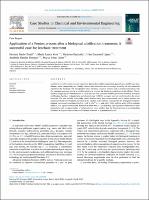Application of a fenton process after a biological nitrification treatment : a successful case for leachate treatment
Date
2022-04-09Author
Traid, Hernán Darío
Vera, María Laura
Escalada, Gustavo
López, Iván Emanuel
Dwojak, Anabela Natalia
Litter, Marta Irene
Metadata
Show full item recordAbstract
Leachate is one of the most complex wastewater due to the variable composition depending on landfill age, time, climate, waste composition, etc. Usually, conventional treatments are not enough to satisfy the environmental regulations for discharge. The incorporation of an advanced oxidation process, such as a Fenton procedure, into the treatment sequence can be a suitable solution to improve the discharge conditions of the effluent. The efficiency of applying the Fenton process to a real leachate from a sanitary landfill, previously treated by biological nitrification, has been evaluated at a preindustrial scale (1000 L), an aspect not very much found in the recent
literature. The raw and the biologically treated leachate have been characterized, and a Fenton process was incorporated into the treatment sequence of the leachate in the effluent coming from the biological treatment.
Optimal operational conditions ([H2O2] = 0.2 M, [Fe2+] = 4 mM, pH 3 (25% sulfuric acid), 0.25% antifoam addition, and agitation) were used. Removal of about 90% of COD and BOD, and significant reductions of other parameters, such as concentration of surfactants and color, confirm that the Fenton process is an outstanding
candidate to improve the conventional leachate treatment at a preindustrial scale.
Collections
The following license files are associated with this item:



